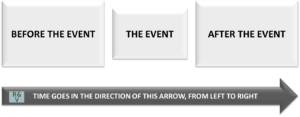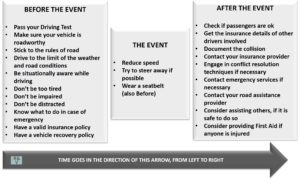(This post is part of the 31010 Series of posts on Risks & Ventures.
For more information on this series please follow this link).
Bow-Tie Analysis is one of the reasons we started to think about creating Risks & Ventures.
Really, this isn’t an exaggeration. Bow-Tie Analysis (or “The Bow-Tie Technique”) might actually be the most universally useful risk assessment technique around, and perhaps even more importantly for those of you who are not risk professionals, it is also a great life hack-style technique for thinking through goals, objectives and problems in general.
What is Bow-Tie Analysis?
In IEC 31010 Bow-Tie Analysis is described as “a graphical depiction of the pathways from the causes of an event to its consequences” (1), and it’s classified as primarily a technique for recording and reporting, although we think it has much broader applicability than just that.
The exact origin of Bow-Tie Analysis isn’t completely clear although online chat suggests that it first appeared in Australia in the late 1970s in relation to hazard management in the chemical engineering industry. Though it’s known with a bit more certainty that the technique was being used by some major oil and gas exploration and production companies from at least the mid-1990s onwards, and from there it began to be adopted more widely in other industries and context.
Because Bow-Tie analysis is intended to be a “graphical depiction“, it’s definitely most easily explained that way too. So here is a simplified Bow-Tie diagram.

As you can see it has the rudimentary appearance of bow-tie with two wings and a knot in the centre, but to understand the concept you also need to imagine time running from left to right following the arrow at the bottom of the diagram. (2)
The “Event” which is sitting on what would be the knot in the centre of the Bow-Tie is the thing that you don’t want to happen or do what to happen if it’s a good thing. This is either going to be a threat or hazard for something you don’t want to happen, or an opportunity for something thing you do.
The left wing of the bow-tie is time before the “Event” happens and the right wing is time after the “Event“.
What Bow-Tie Analysis is telling us in its simplest form, is that if there is something that we don’t want to happen [a bad Event] we need to think in a structured way about the things that might lead up to this Event happening (i.e. its causes). And we also need to think about the things that we can do before this Event happens that will make it less likely to happen and make it less harmful if does still happen.
This can also be expressed by saying: we need to identify and do things that will reduce the Event‘s likelihood and impact, and in formal risk management these would be described as Preventative Controls.
But the Bow-Tie has a right side too as well, because despite our best efforts the undesirable thing we are trying to avoid might happen anyway, so we also need to think about things we can do after it has occurred which will reduce the impact and / or intensity and / or duration of the event, and could also help to promote recovery as fast as possible. These would be described in formal risk management as Reactive Controls. (3)

So Preventative measures or controls before The Event and Reactive ones afterwards.
Some versions of Bow-Tie Analysis also talk about the middle knot when the event is actually occurring as being a time and place where control measures can be used too. This might be described as During the Event or the during phase.
So to recap altogether, what the technique involves is:
- Identifying a bad thing that you are trying to avoid (or a good thing you are trying to make happen if we are talking about a positive outcome)
- Finding some things you can do before this bad thing happens to make it less likely and less harmful (or make it more likely to occur if we are talking about a good thing).
- Finding some things you can do during the event to make it less harmful (or reinforce the opportunity if it’s a good thing)
- Finding some things you can do after the event to contain it and make it less harmful (or exploit and maximise the opportunity further if it’s a good thing)
So Enough About The Theory, How Does This Actually Work?
Let’s illustrate how this ideas works using a hazard that we will all be familiar with: having a vehicle collision.
There’s plenty of things we can do before a collision happens to prevent it or to make it less harmful, and anyone that has a driver’s licence could make a decent list of these quite quickly:
- making sure the vehicle is roadworthy,
- not being impaired,
- not checking your IMs while you are driving,
- trying to avoid driving in bad weather conditions,
- not being too tired,
- being situationally aware, and,
- wearing a seatbelt amongst others.
But then moving right along the bow-tie timeline, imagine that despite taking these precautions you are still struck by another vehicle.
In this specific example there may not be much you can do during the threat event as it is actually occurring, although perhaps you might be able use some steering techniques or something similar to reduce the impact or prevent follow-up secondary collisions.
Wearing a seatbelt would also offer some protection during this event too, although certainly you should be using it in the Before phase rather than be trying to pull it on as a collision is actually occurring.
Then after the collision we might call emergency responders or mechanics, do first aid if its needed, call our insurance providers and gather information in case of future legal claims amongst other activities. All of these would to some extent limit the impact of the event and likely reduce the seriousness of its consequences.
So a simple Bow-Tie Analysis of a vehicle collision could look a bit like this:

Hopefully you can see how in additional to avoiding industrial hazards, which Bow-Tie Analysis was originally conceived for, this kind of structured analysis can also be applied to basically anything that we either do or do not want to happen to us, (4) which could include for example:
- getting a promotion,
- figuring out how to solve a problem at work,
- avoiding redundancy or unemployment,
- buying a house,
- passing an exam or professional certification,
- planning an expedition or side-project,
- losing weight or gaining muscle, and
- purchasing a stock or share.
In each case we need to sit The Event in the middle knot and figure out what we need to do before it, during it and after it happens to either avoid it and reduce it’s impact if it does, or make it more likely to occur and enhance it further if it’s a good thing.
Like brainstorming this technique is highly scalable, meaning that it can be done quickly in sketch-style form or it be the product of detailed study over long-periods of time, depending on the circumstances and the time and resources you have available to you.
It can also be somewhat fractal too, so we can apply it both to a whole project and all the stages and phases that might make up a project, just as effectively.
Things to Consider When Using Bow-Tie Analysis
As with many other risk assessment techniques the quality of the analysis is always going to reflect the level of effort put into it, and there’s definitely a role for research and consulting experts if you don’t know what are the good preventative or reactive controls for any given type of threat or opportunity.
For example if you recognise that information security breaches are something that your business should be concerned about but you don’t know anything about InfoSec, you will need to research this subject thoroughly and probably also consult with someone that does know about it.
Or to be topical at time of writing, you will certainly will want to avoid catching Coronavirus and reduce it’s impact if you are infected, but if you aren’t clear how this type of viral infection spreads or how to deal with it, you will need to watch public health announcements and follow the advice given in them.
Trying Out The Bow-Tie
So why not try it quickly now.
Let’s be positive with this exercise, so try to think of a thing that you want to happen to happen to you or someone you know.
- Draw a quick bow-tie on the top of a piece of paper and write that thing in the middle knot, draw in an arrow running left to right under it.
- Write in three headings BEFORE, DURING and AFTER under the left wing, knot and right wing respectively.
- Think of some things to list under these headings that would make the Event more likely, or might enhance it if it does happen.
- Take a note of areas where you think there are knowledge gaps too. These can be areas for future research as you deepen your analysis and the planning based on it.
I hope you can see how this simple technique really can help you structure your thoughts in the first instance, and then become the basis of an action plan as you starting logically working through each of the items you have listed.
If you are struggling to think of things to write, then why not brainstorm it with a friend, relative or colleague.
As I finish up this post we need to add that just as in real life it is possible to get different styles and colours of neckwear ranging from the plain and monochrome to complex, colourful Paisley-style patterns, there are also different styles of Bow-Tie Analysis, and what we have looked at in this post is the least complicated type of Bow-Tie Technique.
In a complex industrial setting a bow-tie analysis diagram would be much, much more complex and might have several additional elements that we haven’t discussed here.
We may do a future post on this but we think the powerful simplicity of this technique as a way of working through a risk event or realising an objective makes it very valuable to know, and also makes it a real contender for the most useful risk management technique that there is.
(2) If any of you are familiar with the British Physicist Brian Cox’s BBC series Wonders of the Universe, (or are yourself knowledgeable about physics or astronomy), you may be familiar with the idea of the Arrow of Time. You can learn more
in this clip , but the money quote for the context of Bow-Tie Analysis is when he says that time “is simply the ordering of events into sequences, one step after another“.


One comment
Comments are closed.